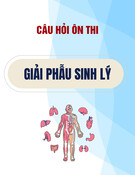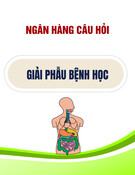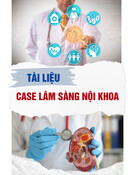
JOURNAL OF 108 - CLINICAL MEDICINE AND PHARMACY Vol. 19 - Dec./2024 DOI: https://doi.org/10.52389/ydls.v19ita.2514
74
Case report: Hereditary angioedema treated with fresh
frozen plasma
Nguyen Thi Phuong Nhung, Vu Thu Trang,
Dao Thi Hong Nga, Tran Phi Hung and Nguyen Lan Anh*
108 Military
Central Hospital
Summary
Hereditary angioedema (HAE) is a rare autosomal dominant disease, characterized by recurrence
swelling of the skin or mucosal tissue, and may cause airway obstruction. It is caused by C1-esterase
inhibitor (C1-INH) deficiency, or dysfunction of C1-INH, therefore increased bradykinin and kallikrein
production, which causes vasodilation, increases vascular permeability and localized fluid extravasation
results in angioedema. The current recommendation for the treatment of an acute attack of HAE is with
C1-INH, or synthetic bradykinin receptor antagonist. However, these drugs are not currently available in
Vietnam, and the price is very expensive. Frozen fresh plasma is considered a safe alternative for patients
because of its rapid and cheap effectiveness.
Keywords: Hereditary angioedema, frozen fresh plasma.
I. BACKGROUND
Hereditary angioedema is a dominant genetic
disease, first described by William Osler in 1888. The
disease includes 3 types: HAE type I due to
deficiency of the quantity of C1-INH, HAE type II due
to C1-INH dysfunction and HAE type III is caused by
mutations in the gene encoding factor XII that
increases bradikynin.
Actually, HAE is often misdiagnosed as IgE-
mediated urticaria. The disease is characterized by
acute, localized, recurrent edema of the skin and
mucous membranes, without itching and urticaria.
Some cases cause edema and airway obstruction,
and the patient can die if not treated promptly,
which is one of the medical emergencies.
Treatment for hereditary angioedema includes
drugs providing C1-INH, bradykinin and kallikrein
antagonists (Icatibant, Ecallantide), but the cost of
these products is too expensive, and they are still
not available in Vietnam. Since other therapies are
Received: 05 December 2023, Accepted: 05 April 2024
*Corresponding author: lananhdl108@gmail.com -
108 Military Central Hospital
not yet available, fresh frozen plasma is often used
as a source of C1-INH to treat acute attacks, or it can
be infused as a prophylactic measure before surgery
to prevent an acute HAE exacerbation. We report a
patient who was diagnosis of HAE and infused FFP
to treat acute attack of HAE.
II. CASE PRESENTATION
A 56-year-old male patient with a healthy
personal history and without a family history of
factors suggesting a genetic disease. The disease
started 1 year before admission to the hospital with
isolated, localized swelling in scattered areas of the
body (abdomen, legs, arms) with no pain, no itching,
and no rash. The disease spontaneously subsided
after a few days without any medication.
Recurrences after the disease last longer than
previous times.
2 days before entering the hospital, the patient
suddenly developed swelling in the chin area. He
took dexamethasone, cefotaxime, and alpha
chymotrypsin, but the disease became worsened,
leading to swelling of the entire face, best observed
with 2 eyelids, lips and tongue, with difficulty in
breathing. With the diagnosis of grade 3







































